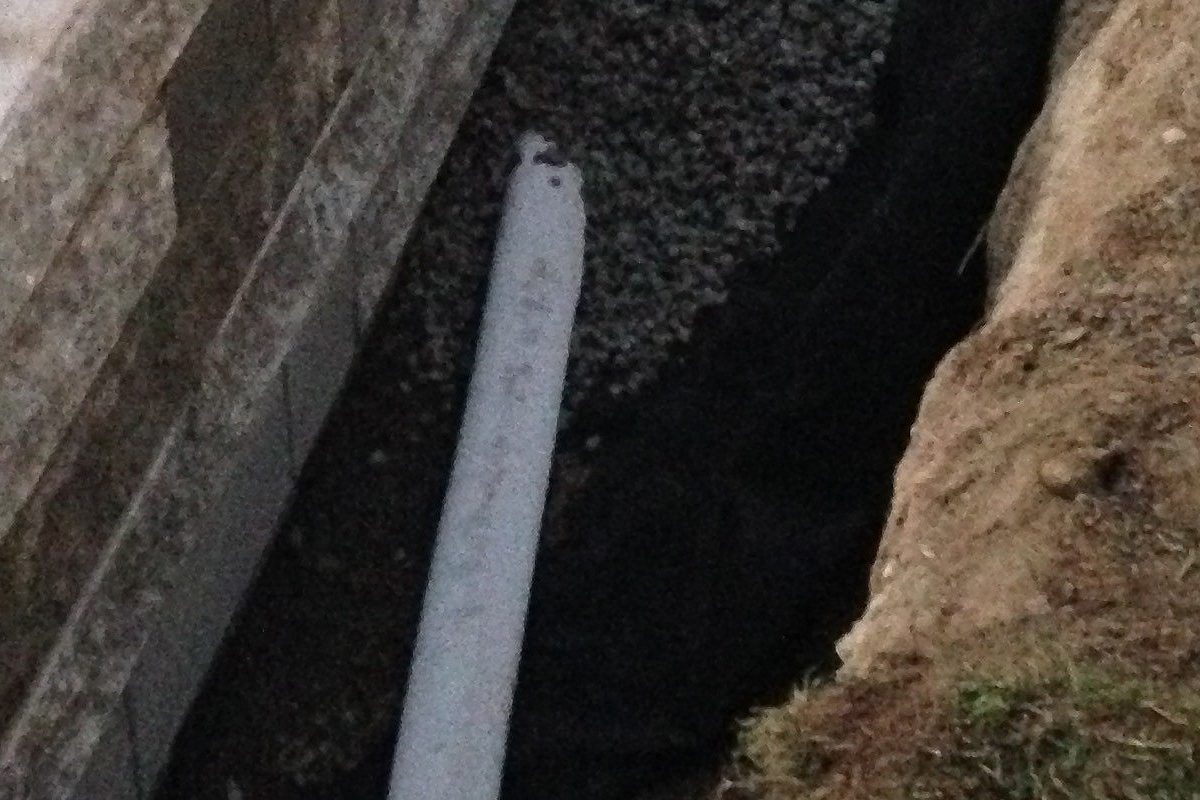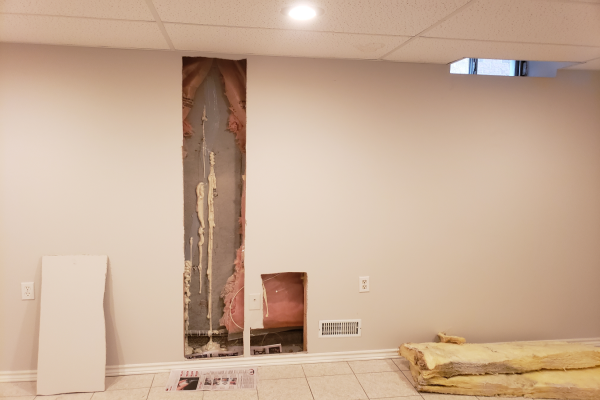It is a widely held belief among homeowners and contractors alike that basement leaks are the result of weeping tile drainage inefficiency. As this leads many to believe that a wet basement is a sympton of clogged weeping tile, it is assumed that the the installation of new weeping tile will prevent future basement leaks and transform what was a wet basement into a dry one.
Over the years we have repaired many basement leaks in brand new homes as well as homes that were but a few years old. If a home is virtually brand new (with new weeping tile, a building code compliant gravel layer, tar sprayed onto the foundation with an air gap membrane wrap), how is it possible that the home could have a wet basement? With all of the drainage and waterproofing provisions mandated by the Building Code, how does one logically conclude that weeping tile replacement will make any difference at all?
To answer these questions we must understand how weeping tile is installed and how it works.
Weeping Tile Installation
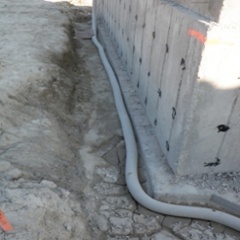
This is a picture showing the installation of weeping tile next to the footing of a home constructed in 2009. It should be noted that the colour of the actual weeping tile is black (see one of the weeping tile images below); it is the filter fabric wrapping that is white. This fabric filters the water entering the weeping tile so that a minimal amount of sediment will enter the weeping tile.
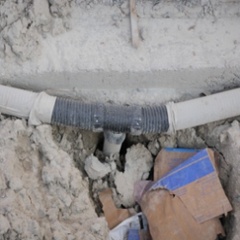
This is a close-up view of how the weeping tile, via a leader line, connects to the storm sewer beneath the street in front of the house. In some instances the weeping tile is directed into the home to discharge into a sump pump liner from which water is pumped to the stormsewer beneath your street.
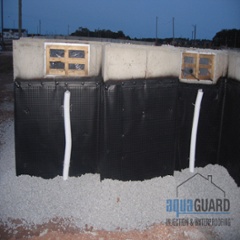
Once the weeping tile is installed it is, by building code, encapsulated by 2 cubic feet of 3/4″ crushed stone per linear foot as shown. The vertical weeping tile was installed to provide drainage for window wells which will be installed once the foundation is backfilled. In this picture you can also see evidence of the tar sprayed onto the foundation wall as well as the air gap (dimple sheet) membrane.
Footing drainage and foundation waterproofing features of weeping tile
This is a close-up view of new weeping tile without filter fabric.
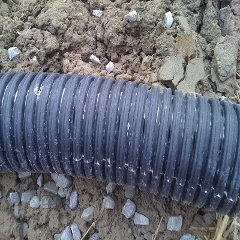
Upon close examination of this picture one can conclude that there are thousands of perforations (slits) in the weeping tile along its entire length around the perimeter of a home. Therefore, if there is an obstruction in one location, or several for that matter, water is able to enter the weeping tile elsewhere and drain away to the designated drainage point.
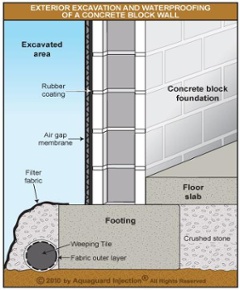
This is an illustration of a typical weeping tile installation as well as the foundation waterproofing provisions. It is important to note that there is a significant amount of gravel encapsulating the weeping tile. This gravel layer provides a secondary drainage path permitting water to flow around the footing, regardless of whether or not the weeping tile is clogged. This gravel is effectively a backup system for obstructed sections of weeping tile. As long as the gravel layer has good drainage properties, drainage around the weeping tile is enhanced. Note also, that the exterior side of the foundation has an applied coating and an air gap membrane. With all of this protection, it’s hard to understand how there could be any basement leak at all.
Below is a picture of traditional terra cotta, or clay, weeping tile. This type of weeping tile was in widespread use throughout the GTA from the 1930’s until the mid to late 1970’s.
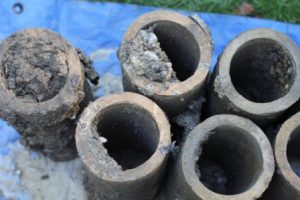
All of these weeping tiles belonged to a single run of weeping tile installed along the side wall of a home built during the 1960s. What is interesting is the extent to which the weeping tile is clogged. The amount of sediment varies dramatically even though the weeping tile was installed essentially in the same location. In this instance there was a relatively clean gravel layer; the condition of the gravel layer was visible during excavation.
Judging by the extent to which each section of weeping tile was obstructed by sediment, the drainage efficiency of the weeping tile itself was reduced. It is not possible to establish the extent to which the drainage around the footing of the home was affected.
Unclogging weeping tile
Once part of the foundation wall has been excavated it is often possible to clear out sediment throughout the system by flushing the weeping tile. Check out this video:
Why Basements Leak
There are many ways in which water can end up in a basement; for more detail about this see sources of basement leaks. Assuming a basement / foundation wall leaks, then the water is clearly getting through the foundation from outside. Water that is able to penetrate a foundation wall must be passing through a crack or a hole of some kind. For water to penetrate a foundation wall there must be some water pressure on the foundation wall (referred to as hydrostatic pressure).
The Benefit of Installing New Weeping Tile
The role of weeping tile is to transport water that has accumulated next to the footing to a drainage point. In theory there should be little hydrostatic pressure against a foundation if the weeping tile is working properly. In the absence of hydrostatic pressure, the foundation could not possibly leak. This is the logic which leads many to conclude that a home with a leaky basement is a home that needs new weeping tile installed. But it’s not that simple…
There are many soil types and subtypes throughout the GTA. With the exception of neighbourhoods on the periphery of Lake Ontario, the majority of homes are built upon and surrounded by clay soils. Clay soil is composed of extremely fine particles and is therefore very dense; as a result, clay soils drain very poorly. The poorly draining clay soils hold a significant amount of ground water and apply a considerable amount of hydrostatic pressure on foundation walls. The poor drainage properties of clay prevent much of the ground water from reaching the weeping tile; therefore, much of the ground water cannot be efficiently drained away. Consequently, installing new weeping tile will not improve the drainage properties of the soil around a home.
Hence our predicament – we have poorly draining clay soils and weeping tile systems which are unable to collect enough of the groundwater around the foundation to sufficiently reduce hydrostatic pressure on the foundation walls (the reason behind basement leaks in new homes). Given this, how can basement leaks be prevented if installing new weeping tile won’t really help? The answer is actually quite simple – prevent the water from penetrating the foundation walls; this is achieved by installing an impermeable barrier around the foundation or by filling those cracks or holes which allow water to penetrate the foundation.
Check out this blog posting: You have a leaky basement, is it time to replace your weeping tile?

